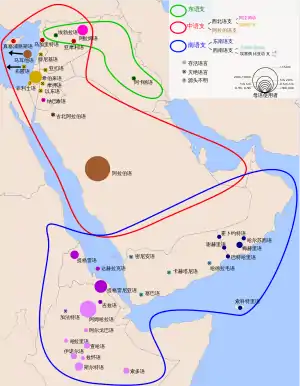闪米特语族
閃米特語族,譯作閃語族、塞姆語族或閃米特語族 ,舊稱叙利亚-阿拉伯语族[2],是亚非语系之下的語族之一,起源于中东地区[3][4],其下属语言约有3.3亿人作为母语,分布于西亚、北非和非洲之角,也有亚非语系侨民生活于欧洲和北美,或高加索和中亚。
| 闪米特语族 | |
|---|---|
| 叙利亚-阿拉伯语族 | |
| 地理分佈: | 西亚、北非、非洲之角、马耳他 |
| 谱系学分类: | 亞非語系
|
| 原始語言: | 原始闪米特语 |
| 分支: |
东闪米特语支 †
西闪米特语支
|
| 语言代码 | |
| ISO 639-2 / 5: | sem |
| – | |
| Glottolog | semi1276[1] |
 闪米特语言的大致历史分布 | |
闪米特语族由哥廷根历史学校的成员于18世纪命名,“闪米特”一词来源于希伯来圣经创世记,是诺亚的三个儿子之一,相传是希伯来人和亚述人的祖先[5]。
現代所使用的其分支語言有阿拉伯語[6]、希伯來語[7]、阿拉姆语[8][9][10]、阿姆哈拉語[11]、提格里尼亚语[12]、提格雷语和马耳他语[13]等。闪米特语族中使用人数最多的语言是现代标准阿拉伯语,而如果包括所有阿拉伯语变体的母语人口在内,阿拉伯语共有3.1亿人作为母语,广泛分布在西亚、北非和东非地区[14]。
闪米特语族下属语言在词法学上有一个被称为“不连续形态”的显著特征,即词汇的词根并不是独立的音节或单词,而是多个互相分离的辅音(通常为三个),借由相应的元音将分离的辅音词根联系起来而组成新词。例如,阿拉伯语中的k-t-b是与“写”相关的词根形式,用这个词根组成的词汇有 kitāb(书的单数), kutub(书的复数)、 kātib(作家的单数)和 kuttāb(作家的复数)等。
分支
- 东闪米特语支
- 中闪米特语支
- 阿拉姆语
- 南部
- 阿拉伯语 (ara)
- 古代北阿拉比亚语 (xna)
- 安达卢西亚阿拉伯语(在西班牙,Andalusian Arabic)(xaa)
- 阿尔及利亚撒哈拉口语 (aao)
- 塔吉克口语 (abh)
- Arabic, Baharna Spoken (abv)
- 美索不达米亚口语 (acm)
- Arabic, Ta'izzi-Adeni Spoken (acq)
- 希贾兹口语Arabic, Hijazi Spoken (acw)
- 阿曼口语Arabic, Omani Spoken (acx)
- 塞浦路斯口语Arabic, Cypriot Spoken (acy)
- Arabic, Dhofari Spoken (adf)
- 突尼斯口语 (aeb)
- Arabic, Sa`idi Spoken (aec)
- 波斯湾口语 (afb)
- 南黎凡特口语 (ajp)
- 犹太-突尼斯口语Arabic, Judeo-Tunisian (ajt)
- 犹太-摩洛哥口语Arabic, Judeo-Moroccan (aju)
- 北黎凡特口语 (apc)
- 苏丹口语 (apd)
- 标准阿拉伯语 (arb)
- 阿尔及利亚口语 (arq)
- 纳季德口语 (ars)
- 摩洛哥口语 (ary)
- 埃及口语 (arz)
- 乌兹别克口语 (auz)
- Arabic, Eastern Egyptian Bedawi Spoken (avl)
- Arabic, Hadrami Spoken (ayh)
- 利比亚口语 (ayl)
- 萨那口语 (ayn)
- 北美索不达米亚口语 (ayp)
- 犹太-也门口语Arabic, Judeo-Yemeni (jye)
- Hassaniyya (mey)
- 马耳他语 (mlt)
- 乍得口语Arabic, Chadian Spoken (shu)
- Arabic, Shihhi Spoken (ssh)
- 犹太-伊拉克口语Arabic, Judeo-Iraqi (yhd)
- Arabic, Judeo-Tripolitanian (yud)
- 迦南语言
- 阿拉伯语 (ara)
- 未分類
- 底雅亚拉语(Deir Alla,古代语言)(xdr,参看The Linguist List)
- 南闪米特语支
- 埃塞俄比亚语言
- 南阿拉伯语言
参考文献
- Hammarström, Harald; Forkel, Robert; Haspelmath, Martin; Bank, Sebastian (编). . . Jena: Max Planck Institute for the Science of Human History. 2016.
- Kitto, John. . London: W. Clowes and Sons. 1845: 192.
That important family of languages, of which the Arabic is the most cultivated and most widely-extended branch, has long wanted an appropriate common name. The term Oriental languages, which was exclusively applied to it from the time of Jerome down to the end of the last century, and which is even now not entirely abandoned, must always have been an unscientific one, inasmuch as the countries in which these languages prevailed are only the east in respect to Europe; and when Sanskrit, Chinese, and other idioms of the remoter East were brought within the reach of our research, it became palpably incorrect. Under a sense of this impropriety, Eichhorn was the first, as he says himself (Allg. Bibl. Biblioth. vi. 772), to introduce the name Semitic languages, which was soon generally adopted, and which is the most usual one at the present day. [...] In modern times, however, the very appropriate designation Syro-Arabian languages has been proposed by Dr. Prichard, in his Physical History of Man. This term, [...] has the advantage of forming an exact counterpart to the name by which the only other great family of languages with which we are likely to bring the Syro-Arabian into relations of contrast or accordance, is now universally known—the Indo-Germanic. Like it, by taking up only the two extreme members of a whole sisterhood according to their geographical position when in their native seats, it embraces all the intermediate branches under a common band; and, like it, it constitutes a name which is not only at once intelligible, but one which in itself conveys a notion of that affinity between the sister dialects, which it is one of the objects of comparative philology to demonstrate and to apply.
- Bennett, Patrick R. . Winona Lake, Indiana: Eisenbrauns. 1998.
- Hetzron, Robert. . London/New York: Routledge. 1997.
- Baasten, Martin. . . Peeters Publishers. 2003: 57–73. ISBN 9789042912151.
- Jonathan, Owens. . Oxford University Press. 2013: 2 [18 February 2014]. ISBN 0199344094.
- Modern Hebrew于《民族语》的链接(第18版,2015年)
- ^ Jump up to: a b Assyrian Neo-Aramaic at Ethnologue (18th ed., 2015)
- Chaldean Neo-Aramaic at Ethnologue (14th ed., 2000).
- ^ Turoyo at Ethnologue (18th ed., 2015)
- Amharic于《民族语》的链接(第18版,2015年)
- Tigrinya于《民族语》的链接(第18版,2015年)
- Ethnologue Entry for Maltese, 21st ed., 2018
- . ethnologue.com. [14 April 2018].
This article is issued from Wikipedia. The text is licensed under Creative Commons - Attribution - Sharealike. Additional terms may apply for the media files.